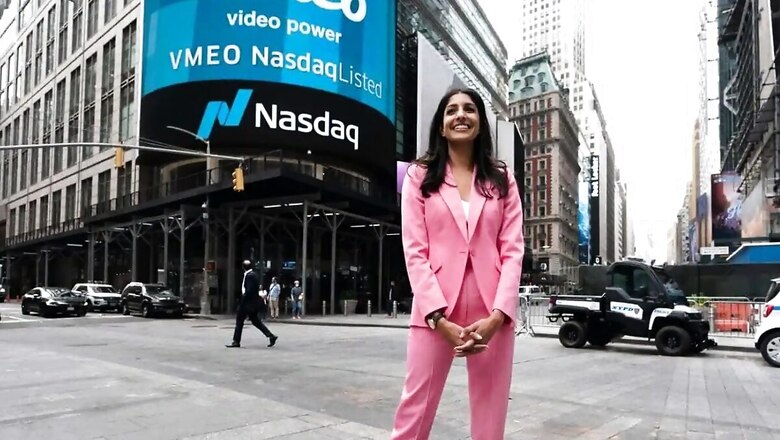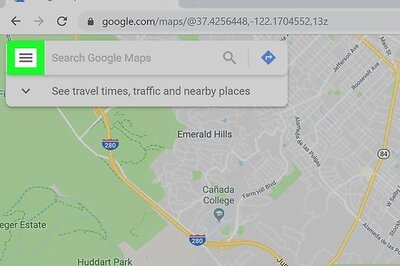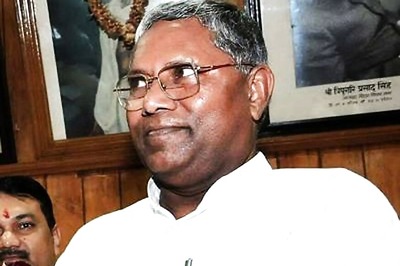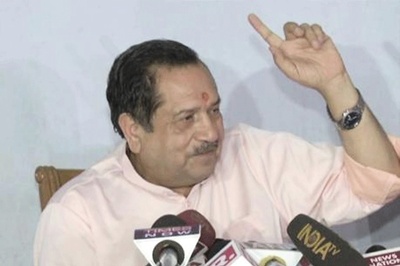
views
It’s rare to see a female CEO ring the Nasdaq stock opening market bell. It’s rarer still when she is of Indian origin and does it minutes after cradling a 2.5 year old baby in her arms. So it wasn’t surprising when Vimeo CEO Anjali Sud’s picture with her son, moments before she took the video software & marketing platform public, went viral last month.
Anjali Sud, born to Punjabi parents who emigrated to the US, gave Vimeo a new lease of life by transforming it from an alternative of YouTube to a software platform that offers companies tools with which they can create, manage and share high-quality videos across platforms. The pandemic year gave Vimeo a shot in the arm, as video consumption went up, as the firm now has over 200 million users globally, with 1.6 million paying subscribers, as of March 2021. Vimeo listed on Nasdaq last month and currently has a market cap of over $7.2 Billion. Sud, who took charge as in 2017, spoke to Moneycontrol via Zoom from New York, on how her Indian roots influenced her leadership, if Vimeo will ever look at audio solutions, her plans to expand in India and how she strikes a fine balance as CEO and mom. Edited excerpts:
Tell us about your backstory- A CEO born to Indian immigrants, who grew up in Michigan. How did this influence you, shape you as a leader?
Both my parents are Punjabi from India. They came to the United States right before I was born. And I grew up in a town in Michigan where we had a tight knit Indian community. I was spending every weekend at dinner parties with aunties and uncles, I was doing Bal Vihar and dance classes, it was a very culturally supportive community. So I grew up with a strong feeling of identity of being Indian but also in the US going to school, being an American. A couple of things that I got from that experience. The fluidity of having to kind of move across cultures and fit in and also stay truly yourself. That helped me have a global perspective.
Vimeo is a global platform, a majority of our users are outside the US, we are growing our teams substantially outside the US and it helps me understand that we come from different backgrounds and how those things can come together in a positive way. The other thing I got is a lot of ambition. My parents left their family and friends to come to the US to pursue the American dream and I grew up always wanting to be a leader and a CEO, because I believe that business can have a positive impact on our communities. I was always working really hard to get good grades, trying to go to the best schools and I definitely got a lot of that from my upbringing.
You have degrees in finance from Wharton, a management degree from Harvard, followed by stints at Sagent, Time Warner and Amazon, before you joined Vimeo in 2014 as the head of global marketing. What kind of change did it take mentally to transition from marketing to becoming the CEO of a software platform in 2017, dealing with product and tech functions?
Before I became CEO, I had done a bunch of different things- from marketing to operations to finance but had never run a product and tech team. That was definitely something I was very proactive about. I spent a year actually leading a product and engineering team, building a bunch of products to prove this is the right strategy for Vimeo. We were pivoting away from being an entertainment destination to being a software company, and so we built software for a year.
It was really important for me to learn the process and mindset of many people who I now lead. The day I became CEO I was very self aware that I did not have a technical background, I asked a lot of questions, I seek to learn and I surround myself with experts and I give them the culture and hopefully the mindset to push back and speak up. I believe that great leaders- they make good decisions and they empower people and that is the skill set I have come to see to define a great leader.
You are not the one who is supposed to be doing all of the work, so it is important to step back and have a strategic perspective, so that is how I think of leading today. So i look to surround myself with people who are far more talented and smarter who are going to help.
It’s exactly been a month since your IPO. How has life changed- does more of your time go into compliance, regulatory aspects?
From a focus and attention perspective nothing has changed. We had a wonderful time celebrating the day we rang the bell and the next morning we wake up and its the same opportunity. Our mission is to enable professional quality videos for every business in the world and is going to take us years, so we just went right back to building.
Going public is not our goal, that is not our mission, it is just a way we can to access different financing vehicles to achieve our mission. I spend a little bit more time speaking to investors but my heart is always going to be in building great products.
I believe we have the opportunity to bring the power of video to every company and team in the world and that’s the main thing that keeps me up everyday.
Vimeo is rooted in video, but the big shift we are seeing now is in audio, especially social audio- from Clubhouse to Twitter Spaces to Facebook testing this feature. Will you ever look at audio?
When you look at the use of video, think about all the things that you do when we work. We use email, image, text- we use video for a very small percentage in the ways we communicate. Our medium term plan is not deviating from video, we are laser focused because we believe the market is early and under penetrated.
Video is very complex- if you want to produce professionally is it quite hard. We want to democratise that through our technology. I actually hope we will drive we will use professional quality video in many many ways than we are doing now.
Long term, if we believe our tech and products can actually serve other formats and other needs in the market, we will always look. But we have a pretty ambitious vision ahead and plenty of work to do.
Where does Vimeo sit when you look at competition? You have Adobe Premiere Pro and then apps like Kinemaster and InVideo, among a whole bunch of apps that’s made making videos very easy. Is being a full stack video solution provider your differentiator?
We think of ourselves as an integrated all in one solution. From getting inspiration for the kind of video, to creating it, to publishing and distributing it with your own branding, getting analytics to being able to monetise your content. And we do everything on a branded, white label basis.
So, unlike a social media platform, we aren’t trying to keep the viewers and the video on Vimeo but we want you to distribute content everywhere at the same time. You need to be able to provide solution across every part of the video ecosystem. Businesses want to use video but they feel it is too much effort. You have to have one solution instead of working with 5 different platforms and 4 different software products.
Take us through your plans for India. India has over 600 mn smartphone users, there are plans for 5G, data consumption here is among the highest in the world. What potential do you see here, how big is India for you right now?
The need for video is global, we have seen growth in every market since the pandemic in the usage of new product tools. A lot of new investments coming to India in terms of infra will enable an even bigger market opportunity. Certainly an area we are thinking and excited about.
You will see us invest in our team in India, We have an office in Bengaluru, I expect that office to be our second largest outside our HQ. We are growing very quickly and we are looking at ways to optimise our products to be more localised for different regions. The Asia Pac region is high priority area and we are hiring.
Before the pandemic, I went once or twice a year to visit the team in Bengaluru, it is one of my favourite places to be and I cannot wait to get on a plane and come back. Streaming is really taking off in India, Vimeo OTT is seeing a lot of interest from content creators. Are are trying to rethink virtual events and make webinars less boring.
What’s view on the future of work- are you an advocate of people coming back to work, to foster social capital? Or will the future of work be hybrid?
I think it is so exciting that we are all asking this question and taking the opportunity to reimagine what works. I think there is a lot value to inter personal interactions, there is a lot of value to having an office and I want to give that to our employees. But we must provide more flexibility and take advantage of distributed workforces. So you will see Vimeo look to do both, exactly how we do it is still something we are figuring out.
What’s it like to be a working mom who is a CEO? How do you balance it all? What are your hacks, tips and tricks?
It’s hard. I can’t pretend I don’t struggle with it. I don’t strive for balance anymore, I don’t know if that is realistic. I look for integration. I try to bring as much of my whole self to work, trying to split the two is hard. It takes a village and I have a wonderful support network. I could never do it without them. My one hack is on Sundays, I hand my son to my husband and go on a 2 hour just me walk around the city and just get me time to think through everything and that has been crucial for my sanity during the pandemic.
In the beginning of the interview, you said you always wanted to be CEO. How did that happen?
My father is a physician but he is also an entrepreneur and he runs a manufacturing plant in our hometown in Michigan, So I grew up watching him building a business, I would on factory floors and see him pouring his heart and soul and that is when I got the bug. Leadership changes depending on where you are in your career. Today I see my job as setting a clear vision, expectations, being consistent and focussed and getting the right resources and empowering the team to be successful.
What challenges do you foresee for Vimeo- external/Internal?
Our number one challenge and opportunity is execution. Since the pandemic we have had customers come to us with a long list of products and feature that they need with video and we have been building those things. I think this market is huge. There is going to be competition but that just pushes us to do better.
Read all the Latest News, Breaking News and Coronavirus News here.




















Comments
0 comment